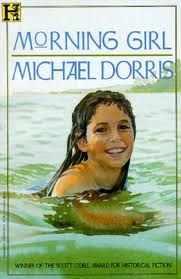A Single Shard by Linda Sue Park. Dell Yearling, 2003. 152 pages.
Plot: This story takes place in 12th-century Korea and centers around a twelve year old orphan name Tree-ear. He lives homeless under a bridge with Crane-man who has graciously taken him in to help provide food and shelter which they must constantly scavenge on a daily basis. Tree-ear becomes fascinated by the work of Min, a village potter, and after inadvertently breaking one of the potter’s creations, begins to work off his debt by collecting wood, carrying clay and cleaning. After a year of “apprenticeship” Tree-ear, who has been dreaming of the day he can create his own pot, is devastated to learn the potter’s trade is only handed down from father to son as Min unkindly and with resentment states “You are not my son!” Tree-ear is conflicted, but agrees to undertake a difficult and dangerous journey (which Min could never undertake because of his age) to carry some of Min’s work to the royal court in hopes of landing a commission. Tree-ear is challenged by the journey, arrives with only “a single shard”, is successful and returns to tragedy, transformation and hope.
Review/Personal thoughts: I was curious about the setting and theme of this book. After reading about half of it, I was not impressed, but from the moment of the devastating realization about the requirement of father to son for the potter’s trade I was drawn in and held there for the remainder of the book. The range of emotions and experiences of the main character are well-crafted and easy for the reader to recreate. The reader explores themes of family, homelessness, trust, perseverance, creativity, fear, honor and gratitude. Although set in a place long ago and far away from modern America, tweens will connect with Tree-ear and share his journey with empathy and interest. I would have no problem recommending this book to a tween.
Genre: Fiction
Reading Level: 6.7 Interest level: Ages 9 to 13 years old
Awards: 2002 Newbery Medal


